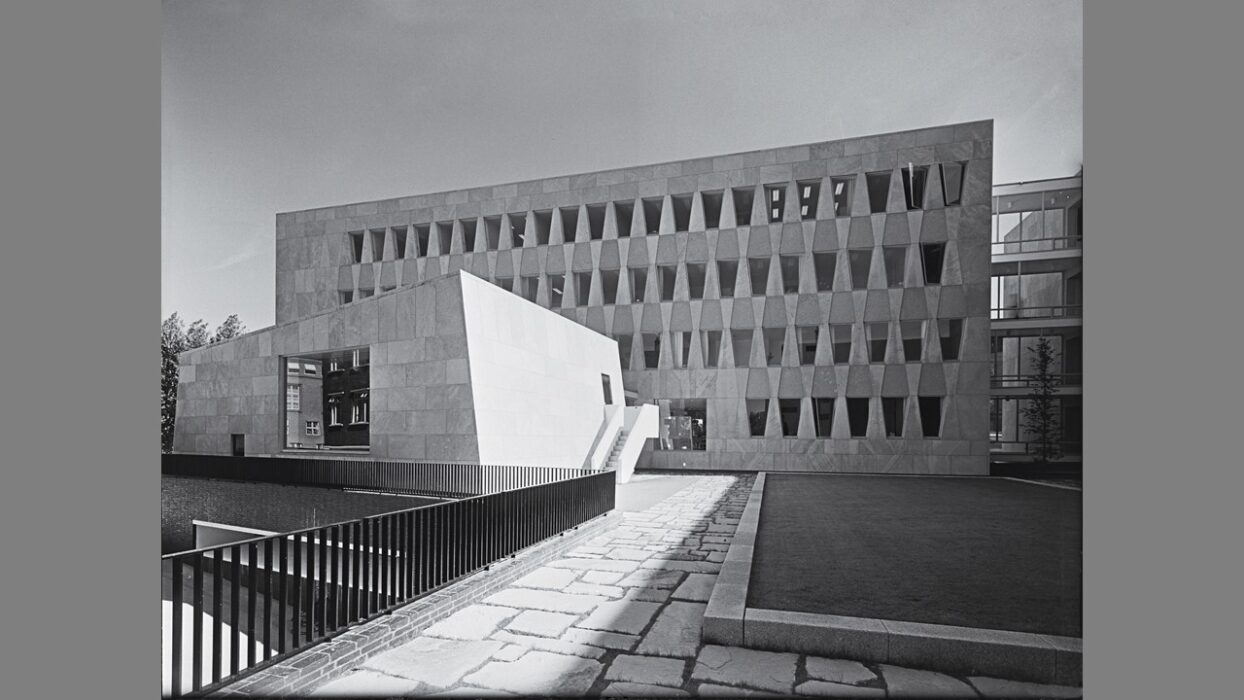Edward Durell Stone’s US Embassy in New Delhi was among the most widely celebrated of any of the modernist projects built by the State Department during the Cold War.
Frank Lloyd Wright hailed Stone’s design, describing it as “one of the finest buildings of the last 100 years, and the only embassy to do credit to the United States.” Wright’s admiration was echoed by architects, critics, and the public alike. Publications ranging from Architectural Forum to the Boston Globe described Stone’s design as an “American Taj Mahal,” with Time, Life, and an array of other magazines echoing the chorus of praise in articles and editorials describing the building as a fitting symbol of American democracy.

Reception in the main lobby of the chancery
Architectural Record wrote: “The shimmering dignity of the recently completed United States Embassy in New Delhi…seems to be amply fulfilling its role, designated by the State Department’s Foreign Buildings Office, of serving as a symbol of friendship and goodwill. During the two years of its much-publicized construction, Eastern and Western skills were combined with great care…The result is an elegant merger of the tastes and techniques of the cultures of the two countries.”
Stone’s architectural philosophy owed its inspiration in part to the modernist movement’s interest in the future, and in part to the arts and crafts movement’s interest in the craftwork of the past. In 1957, Architectural Record wrote that Stone “…has been steadfast to his image of architecture as fine art. Architecture to him is individual creative expression, and he has resisted being cataloged as a disciple of any contemporary school.”
The New Delhi embassy is perhaps Stone’s most successful expression of this ethos. Architectural Record wrote: “To achieve a formal expression of both character and dignity, the general design of the office building resembles the traditional Greek or Indian temple. The two-story building encloses an open aquatic garden, which is to be covered by aluminum stripping suspended on cables. All offices are one bay in depth and all corridors become open balconies fronting the central garden. The design employs the surrounding podium of the Indian temples in that locale. Exterior of the office building is of ornamental perforated tile, marble, and concrete frame.”

The entrance to the ambassador’s residence
Architectural Forum praised the resulting design, writing that “Stone knew where to stop and keep the embassy his own. … His design never becomes just an architectural dialect story; its great charm is that it is a faithful abstraction of the old spirit, without being an imitation temple.”
In describing his approach to the design, Stone wrote: “I decided to place the structure on a platform or podium under which automobiles could be sheltered from the 120-degree sun of India. … [T]he idea of a monumental building rising from a sea of multi-colored, tail-finned automobiles is simply revolting.”
In consideration of the climate in New Delhi, Stone wrote: “I elected to place the office on two stories around a water garden to gain the cooling effect of the fountains and pool. To shade windows and other glass areas from the sun and reduce glare, I adopted a terrazzo grille for the exterior walls—an ancient principle in tropical climates.”
The New Delhi embassy is most often praised because Stone’s design blends architectural modernism with India’s vernacular architectural traditions. Architectural Forum wrote: “What Ed Stone sought to do was design a building that would represent this country’s democratic vitality and romance, its pleasures as well as its power, its strength, all without ponderous weight. Just completed, his glittering, eye-luring structure…fulfills most of the extravagant hopes aroused by first sketches three years ago, which awoke many people to the possibilities of a new government style.”

The chancery’s central water garden
The building was of enormous symbolic importance to India, representing a significant and conspicuous investment in the future of US-Indian relations. India’s Prime Minister, Jawaharlal Nehru, joined in the chorus of praise, making the New Delhi embassy a major diplomatic coup for the United States. In 1962, Jacqueline Kennedy visited the new embassy as First Lady — cementing a period of strong relations between the two countries by bringing the court of “Camelot” to the Indian capital.

First Lady Jackie Kennedy visiting the embassy (1962)
The US Embassy continues to be housed in Stone’s New Delhi building. Fortunately, and unlike most of the other Cold War embassies, the New Delhi embassy is built on a large, 30-acre campus and can be better adapted to today’s needs. The State Department is currently employing Weiss/Manfredi to undertake a preservation-oriented redevelopment of the site that meets 21st-century security needs and corrects flaws in Stone’s building while respecting the essence of his celebrated design. The embassy is a designated landmark and was listed on the Secretary of State’s “Register of Culturally Significant Properties” in 2004.
 David B. Peterson is CEO of Onera Group, Inc. and Executive Director of the Onera Foundation, a private foundation dedicated to supporting historic preservation. Mr. Peterson is Board Chair of the Harlem Academy school, an independent school offering students a leading education regardless of economic circumstance. He serves on the Advisory Council of the Glass House, a National Trust Historic site. He holds a BA from Dartmouth College, an MBA from NYU, and a MS in Historic Preservation from the Columbia University Graduate School of Architecture, Planning and Preservation. Click here to order ‘US Embassies of the Cold War’.
David B. Peterson is CEO of Onera Group, Inc. and Executive Director of the Onera Foundation, a private foundation dedicated to supporting historic preservation. Mr. Peterson is Board Chair of the Harlem Academy school, an independent school offering students a leading education regardless of economic circumstance. He serves on the Advisory Council of the Glass House, a National Trust Historic site. He holds a BA from Dartmouth College, an MBA from NYU, and a MS in Historic Preservation from the Columbia University Graduate School of Architecture, Planning and Preservation. Click here to order ‘US Embassies of the Cold War’.




